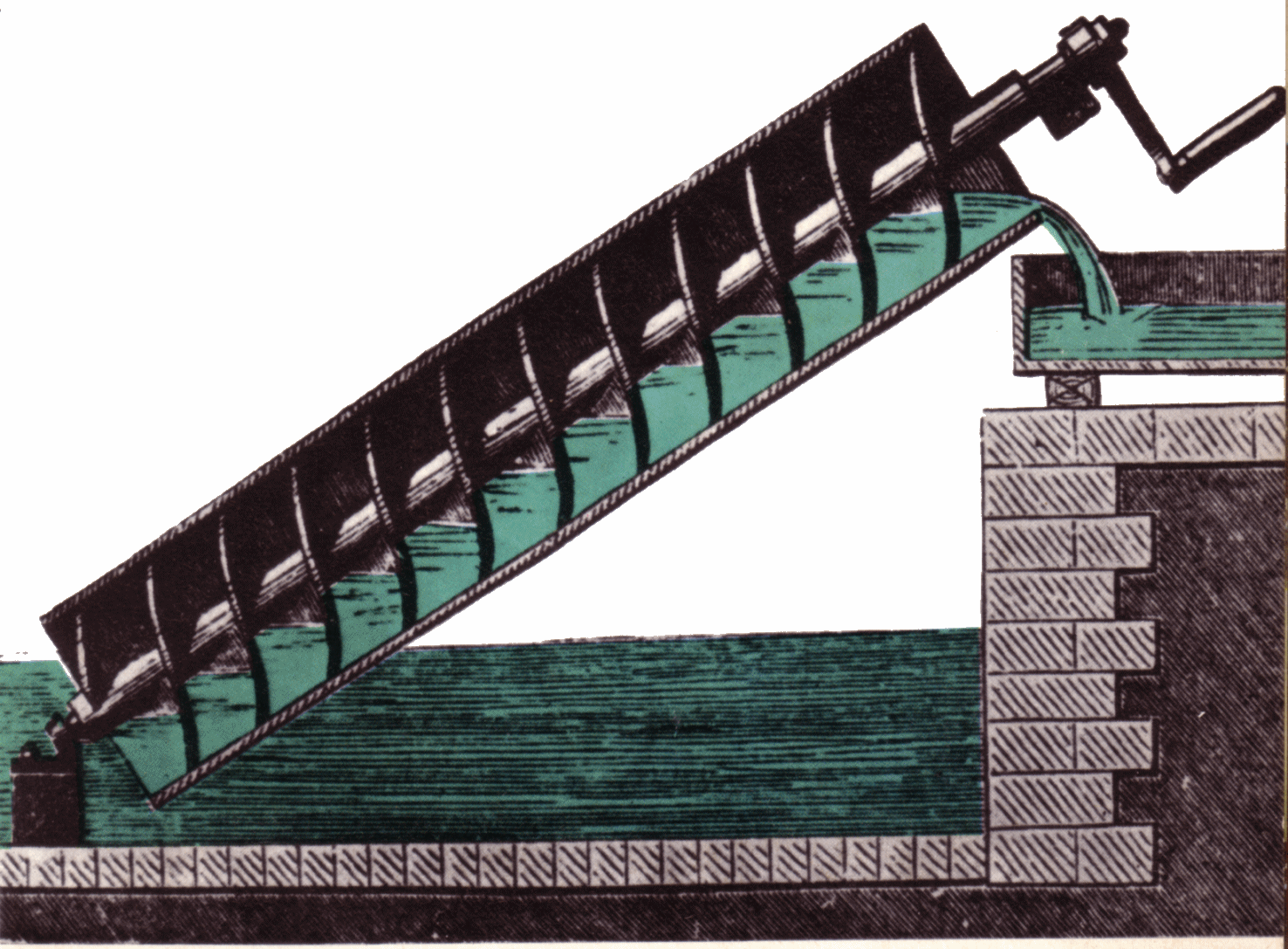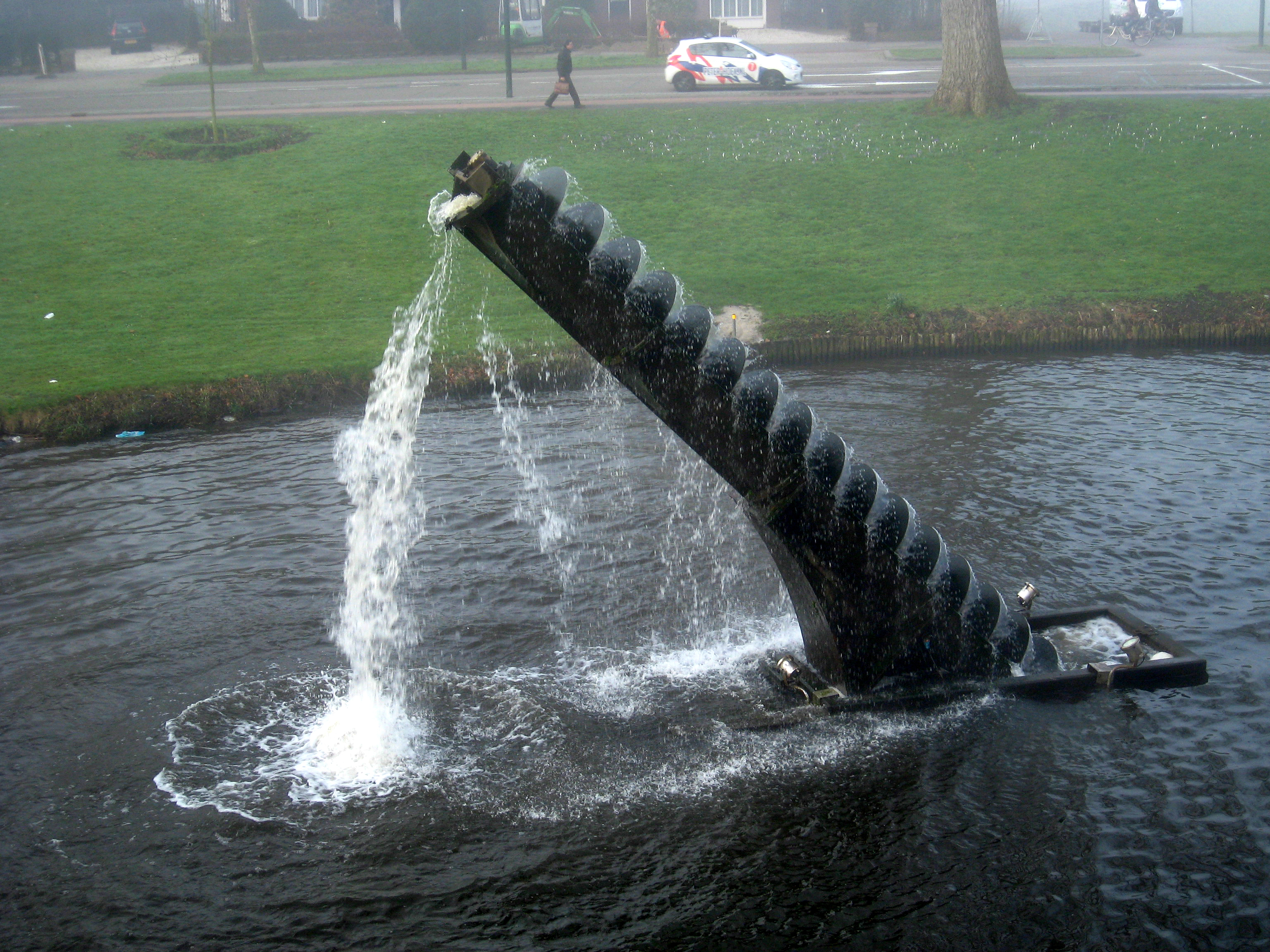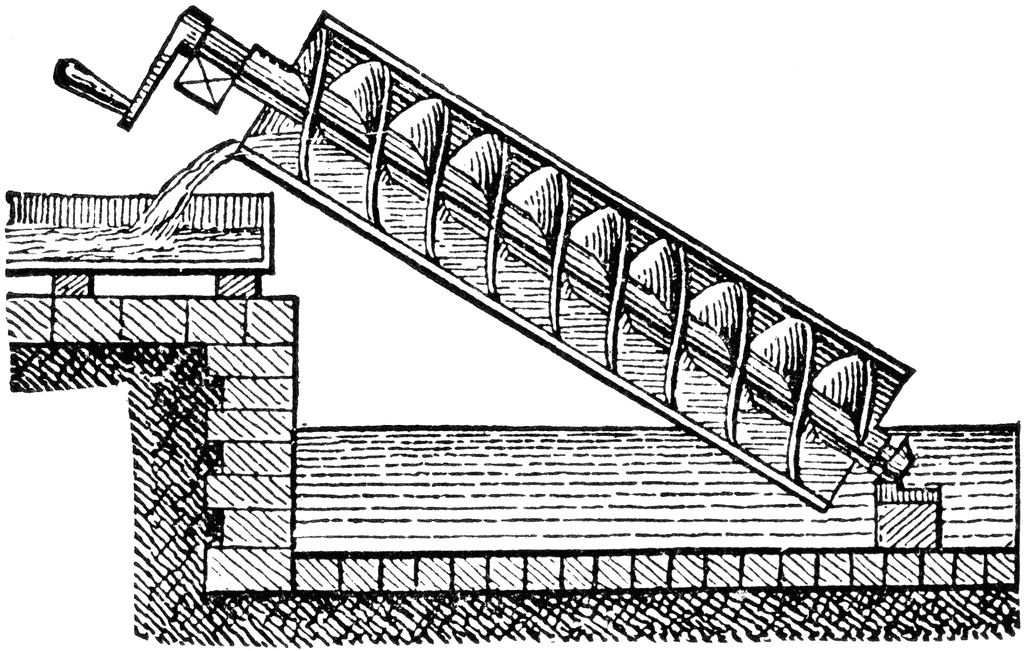Archimedes' screw
An Archimedean screw is a conveyor system, which consists of a spiral wound around a shaft and a trough. The term " screw pump " would actually be more appropriate and is, for example, in English (Screw Pump) also used. However, the term in English was already assigned elsewhere and so oriented themselves to the Dutch term " Vijzel " which means "snail". The term " screw pump " has established itself and it is usually never spoken of an Archimedean screw. The main application is the transport of water to a higher level for irrigation and drainage purposes. Their invention is attributed to the ancient Greek mathematician and engineer Archimedes in the 3rd century BC. Because of their reliability and low maintenance, they are used mainly in sewage treatment plants. A little known advantage here compared to the centrifugal sparing with the medium, which greatly facilitates the wastewater treatment.
Principle
The screw is located in a closely matched trough or tube made of steel or concrete and rotates about its central axis. Through the screw and the trough chambers are formed, in which the water is screwed up. These chambers are bounded above and below by a respective blade portion of the spiral. Due to the rotation of the screw all the chambers move in the direction of the screw end. At the end of the screw the water from the dissolving chamber runs out, at the beginning of the screw is a new chamber that fills with water from the inlet.
The Archimedean screw is a special case of the screw conveyor, since only gravity is used indirectly for the forward transport of the delivery medium. For this reason, the subject of the Archimedean screw horizontally or obliquely upward, whereas screw conveyors are also able to promote goods vertically.
Historical application
Antiquity and Middle Ages
Even in ancient times found Archimedean screws use. They were powered by a windmill or by muscle power, along rivers, through a water wheel. Snails could be prepared, inter alia, by helically wrapped a wooden core in several layers with flexible rods and this verpichte ( sealed with pitch ).
These screw pumps are referred to in ancient times because of its resemblance to a spiral sea shell in Greek and in Latin cochlias cochleas.
Exact details on the construction of a screw pump are handed down by Vitruvius. In his book " Ten Books on Architecture " ( " De architectura libri decem "), which was v. 33-22 AD, he is in the band X Mechanical Engineering ( " Machinarum ", there chap. 6) requirements together, after which the axis is to be made from a round wooden pole whose diameter is supposed to have 1/16 the length. The periphery is divided into eight equal sections, the length as well, so that a square distribution is produced. The leaves of the screw pump are created diagonally across the intersection points of the squares of flat strips of willow or willow wood and sealed with pitch. It is driven by human power ( " hominibus calcantibus " ), but is not further specified. Ancient representations on murals and terracotta show the drive by a man who drives the drum through kicking. Rough recalculations of the pump performance come at a continuous power of about 100 watts and a total efficiency of 40 % on a capacity of about 10,000 liters per hour.
Dutch polder drainage
Few hundred years ago, the principle of the Archimedean screw from the low countries was rediscovered. They used for dewatering of whole areas in ( " polder mills " ) that were powered by wind power. In this manner, the windmill has become the symbol of the Netherlands. " Flutter " ( Mills ) ( in Holland " Tjasker ( moles ) " ) were yet inexpensive and easy installations that could be manually rotated in the wind.
By 1880 there were in East Frisia still 130 such drainage mills; to this day, for example, the water pumping mill Wedel field in the sand. Wall thickness and diameter of the central tube to determine their resistance to the bending moment and thus the achievable heads. Long time no screw pumps were used with lengths greater than 10 m, they broke after a short time. Only when it was noticed that they tend to sag by the displacement of the water in operation up, you could run a long screw pumps by adjusting the appropriate parameters. The first, with 18 m length significantly larger machines were shown at the " Expo '58 " in Brussels in a shop pumping station of the Dutch pavilion and were for experts a real sensation. Rises exceeding the screws are arranged in a cascade. This can also be seen on an ancient depiction of the Roman period.
Essential dimension sizes
The figure shows the significant main dimensions:
- : Core tube diameter
- : Screw diameter
- : Angle of inclination
- : Constructive discharge head
- : Water level difference
- : Required hydraulic head
- : Maximum head
- : Coefficient ( here: 4)
- : Bladed length
- : slope
- : touch point
- : filling point
- : Fall point
- : About fall point
- : Stagnation point
Examples
Flutter - mill or Flutter in Ostfriesland for dewatering
Snails cascade in Southern Europe
From Vitruvius described Archimedes' screw
Archimedes screw in the city park of Bonn village in the Black Forest
And ... in the Britz Garten Berlin
Reversal of the principle
The Englishman Francis Pettit Smith and John Ericsson, the Swede returned the principle independently of the others in the 19th century. So far, the screw was anchored and the water was able to overcome a vertical distance. When reversing, although the bolt was still stationary, but anchored in a float. The driven force with machine screw now had the task of forwarding through the water. The movement of the screw, the water was moving in one direction, so was a movement of the float through the propeller ( the thrust has to be higher than the head wind and the current, also had the inertia of the float to be overcome ). The water was then also conveyed ( as the reverse ), but in the horizontal direction. Later propellers were also used for aviation and experimentally for the railroad (eg Rail Zeppelin ).
Others
- The ship's propulsion system in 1875 that entered service in armored frigate General - Admiral had one of the Archimedean screw similar construction.
- Similar -looking, but according to a different principle from the eccentric screw pump works.
- The reversal of the working principle, in which the screw is driven by the weight of the water, the hydrodynamic screw.









